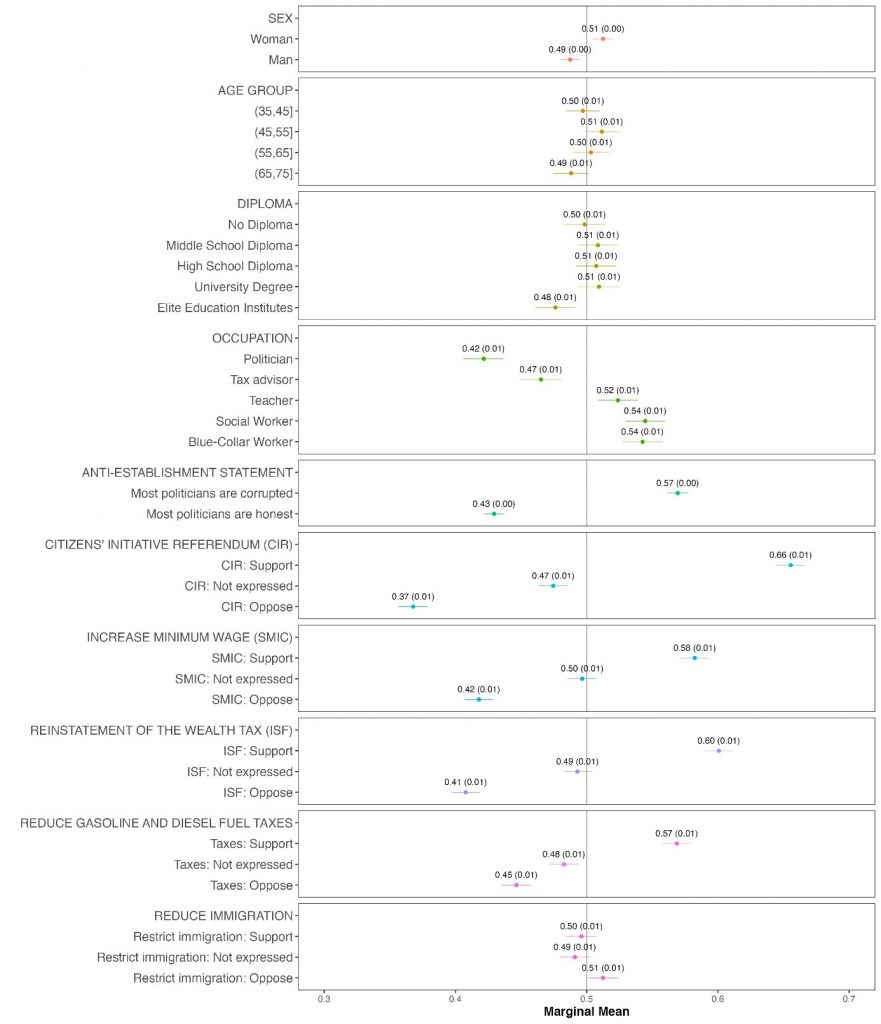Frédéric Gonthier is professor of political science at Sciences Po Grenoble and at the Pacte laboratory (@FredGonthier). Tristan Guerra is an ATER at Sciences Po Grenoble and a doctoral student in the Pacte laboratory (@TristanGuerra_)
The Gilets Jaunes vote has often been pigeonholed as a rejection vote. In a recent article, we draw on an experiment conducted during the movement to highlight that programmatic considerations, starting with the Citizen Initiative Referendum, occupy first place in their voting logics.
A large body of literature has examined the links between voter characteristics and candidate characteristics. In particular, it has been emphasized that citizens prefer candidates who are similar to themselves. This principle ofvoter-politician congruency can be broken down into three main dimensions: a statutory dimension (we prefer a candidate with a similar social profile), an ideological dimension (we prefer a candidate who shares our political ideas and values), and a more programmatic dimension (we prefer a candidate who defends our demands, without necessarily being of the same social origin or political color).
And yet, how do voters arbitrate between these three conditions when they are not simultaneously fulfilled by the same candidate? In a situation of constrained electoral choice, will we prefer a candidate who resembles us politically to one who resembles us ideologically, or who resembles us programmatically rather than ideologically?
The Gilets Jaunes movement is a particularly interesting case study for examining this type of dilemma. In addition to the questions it raised about the legitimacy and nature of representation, the movement was in fact traversed by a strong tension between a demand for statutory congruence (a representative drawn from the people), a demand for ideological congruence (a representative who rejects the party system and the left-right opposition) and a demand for political congruence (a representative who supports the grievances expressed by the movement).
A realistic grasp of electoral choices
To better understand how the Gilets Jaunes' electoral preferences are organized, we resorted to joint experimentation, a method often used in political science to approach the reality of electoral trade-offs. The experiment was conducted as part of a large online survey, administered to 2,743 participants or supporters of the movement between December 2018 and March 2019.
In concrete terms, we asked a question formulated as follows:
"In the following table, candidates A and B are two candidates who are seeking your vote to be elected to the National Assembly in the next legislative elections. Please read the description of each of the two candidates, then indicate your preference between them. Even if you're not entirely sure, please indicate which of the two you prefer.
A series of vignettes were then presented, on which appeared the various traits tested and pertaining respectively to the candidate's persona, ideology and the main demands put forward by the Gilets Jaunes movement (instituting the Citizen's Initiative Referendum, raising the SMIC, re-establishing the ISF, reducing fuel taxes - to which was added the limitation of migratory flows that has caused debate within the movement).
The principle of the experiment is that each respondent is offered a choice between (three) pairs of candidates whose attributes are drawn at random (figure 1). On this basis, it is possible to statistically isolate the specific effects of each attribute, while controlling for the respondents' social and political characteristics.

"RIC in all matters
Figure 2 shows the degree of support for each attribute, net of support for the other traits tested. Three main results emerge. Firstly, gender, age and level of education are not very divisive overall, with the exception of candidates with degrees from the grandes écoles, who are largely rejected. Secondly, a candidate who defends the movement's key demands tends to be preferred to a teacher, social worker or blue-collar worker - closer, therefore, to the average Gilets Jaunes profile in terms of profession. This type of candidate is also preferred to one who would signal a form of ideological proximity to the movement by asserting that "most politicians are corrupt".
Finally, among the demands of the Gilets Jaunes, the RIC is the most strongly supported; which is consistent with the centrality progressively gained by this theme in the movement. Additional analyses show, moreover, that a candidate defending the RIC will be preferred in all scenarios, whatever his or her other characteristics therefore. Clearly, the Gilets Jaunes' preference for a candidate supporting the RIC conditions all their other preferences.

The voting logic of the Gilets Jaunes also integrates programmatic considerations
A large number of commentators have asserted that the Gilets Jaunes vote would above all be of the protest type, quick to give in to the populist appeals of charismatic leaders. Our results suggest that this reading should be put into perspective. Far from being motivated solely by rejection of the elites, the voting logic of the Gilets Jaunes also incorporates programmatic considerations, starting with the RIC. From this point of view, the Gilets Jaunes are no different from ordinary voters, whose researchers have emphasized that they prefer representation based on shared political preferences (substantive representation) to representation based solely on shared social characteristics (descriptive representation).
Above all, our results shed light on the performance in the presidential election of the candidates who most openly supported the RIC - namely Jean-Luc Mélenchon, Marine Le Pen and Jean Lassalle, whose substantial electoral gain in the first round (666086 votes more than in 2017) is no doubt largely due to the endorsement of his program by collectives working to implement the RIC. Of course, support for democratic reform is not enough to get a candidate elected. But it does have the merit of revitalizing a campaign and bringing back to the polls a popular electorate that is demobilized but sensitive to the issue of democratic representation.
The full study is available here. This post was also published on The Conversation website in partnership with Poliverse.